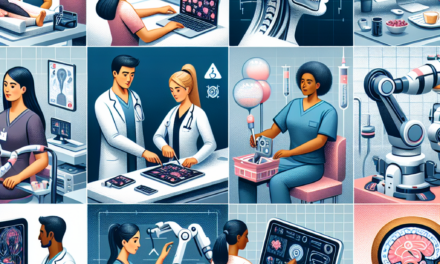Revolutionizing Patient Care Through Advanced Mobility Solutions
In the rapidly evolving landscape of healthcare, the integration of advanced mobility solutions is transforming patient care. These innovations not only enhance the efficiency of healthcare delivery but also significantly improve patient outcomes. This article explores the various facets of advanced mobility solutions in healthcare, including their impact on patient engagement, telehealth, data management, and the overall patient experience. We will delve into five key subtopics that highlight the importance and effectiveness of these technologies in revolutionizing patient care.
1. Enhancing Patient Engagement Through Mobile Health Applications
Mobile health applications, or mHealth apps, have emerged as a powerful tool for enhancing patient engagement. These applications allow patients to take an active role in their healthcare by providing them with easy access to their health information, educational resources, and communication channels with healthcare providers.
One of the primary benefits of mHealth apps is their ability to facilitate self-management of chronic conditions. For instance, diabetes management apps enable patients to track their blood sugar levels, medication adherence, and dietary habits. A study published in the Journal of Medical Internet Research found that patients using diabetes management apps showed a significant reduction in HbA1c levels compared to those who did not use such tools.
- Accessibility: Mobile health applications are accessible 24/7, allowing patients to engage with their health data at their convenience.
- Personalization: Many apps offer personalized health plans and reminders, which can lead to better adherence to treatment protocols.
- Education: mHealth apps often include educational resources that empower patients with knowledge about their conditions.
Moreover, these applications can facilitate communication between patients and healthcare providers. Features such as secure messaging and video consultations allow for timely interventions and support. For example, the app MyChart enables patients to communicate with their healthcare team, schedule appointments, and access test results, thereby fostering a collaborative approach to care.
However, the effectiveness of mHealth apps is contingent upon user engagement. A study by the Pew Research Center found that while 85% of smartphone owners use health-related apps, only 30% use them regularly. To address this challenge, developers must focus on creating user-friendly interfaces and incorporating gamification elements to encourage consistent use.
2. Telehealth: Bridging the Gap in Patient Care
Telehealth has gained significant traction, especially in the wake of the COVID-19 pandemic. This technology allows healthcare providers to deliver care remotely, thereby overcoming geographical barriers and increasing access to services. Telehealth encompasses a range of services, including video consultations, remote monitoring, and mobile health applications.
One of the most compelling advantages of telehealth is its ability to reach underserved populations. According to the Health Resources and Services Administration (HRSA), approximately 20% of Americans live in rural areas with limited access to healthcare facilities. Telehealth can bridge this gap by providing these individuals with access to specialists and primary care providers without the need for extensive travel.
- Cost-Effectiveness: Telehealth can reduce healthcare costs by minimizing the need for in-person visits and hospitalizations.
- Convenience: Patients can receive care from the comfort of their homes, which is particularly beneficial for those with mobility issues.
- Continuity of Care: Telehealth facilitates ongoing monitoring and follow-up care, which is crucial for managing chronic conditions.
Case studies have demonstrated the effectiveness of telehealth in various settings. For instance, a study conducted by the University of California, San Francisco, found that telehealth consultations for mental health services resulted in high patient satisfaction rates and improved clinical outcomes. Patients reported feeling more comfortable discussing sensitive issues in a virtual setting, leading to better engagement in their treatment plans.
Despite its advantages, telehealth also faces challenges, including regulatory barriers and concerns about data privacy. The rapid expansion of telehealth during the pandemic prompted temporary regulatory changes, but the long-term sustainability of these services will depend on the establishment of clear guidelines and reimbursement policies.
3. Data Management and Analytics: Driving Informed Decision-Making
Advanced mobility solutions are not just about improving patient interactions; they also play a crucial role in data management and analytics. The integration of mobile technologies in healthcare generates vast amounts of data that can be harnessed to drive informed decision-making.
Healthcare organizations can utilize data analytics to identify trends, monitor patient outcomes, and optimize resource allocation. For example, predictive analytics can help identify patients at risk of hospital readmission, allowing healthcare providers to implement targeted interventions. A study published in the American Journal of Managed Care found that hospitals using predictive analytics reduced readmission rates by 20%.
- Real-Time Monitoring: Mobile devices enable real-time monitoring of patient health metrics, allowing for timely interventions.
- Population Health Management: Data analytics can help identify health disparities within populations, guiding targeted public health initiatives.
- Operational Efficiency: Analyzing data can streamline administrative processes, reducing costs and improving patient flow.
Moreover, the use of electronic health records (EHRs) integrated with mobile solutions enhances data accessibility for healthcare providers. This integration allows for seamless sharing of patient information across different care settings, improving coordination and continuity of care. For instance, the Epic EHR system offers mobile access to patient records, enabling clinicians to make informed decisions at the point of care.
However, the effective use of data analytics in healthcare requires addressing challenges related to data privacy and security. As healthcare organizations increasingly rely on mobile technologies, they must implement robust cybersecurity measures to protect sensitive patient information from breaches.
4. Improving the Patient Experience with Wearable Technology
Wearable technology has emerged as a game-changer in patient care, providing continuous monitoring and real-time feedback on health metrics. Devices such as smartwatches, fitness trackers, and medical wearables empower patients to take charge of their health and well-being.
Wearables can track a variety of health metrics, including heart rate, physical activity, sleep patterns, and even blood glucose levels. This data can be invaluable for both patients and healthcare providers. For example, a study published in the Journal of the American College of Cardiology found that patients with heart conditions who used wearable devices experienced improved outcomes due to enhanced monitoring and timely interventions.
- Chronic Disease Management: Wearables can help patients manage chronic conditions by providing real-time data that informs treatment decisions.
- Preventive Care: Continuous monitoring can facilitate early detection of health issues, allowing for timely preventive measures.
- Patient Empowerment: Wearables encourage patients to engage in healthy behaviors by providing feedback and setting goals.
Case studies illustrate the effectiveness of wearable technology in improving patient outcomes. For instance, the Apple Heart Study, conducted in partnership with Stanford University, utilized the Apple Watch to monitor atrial fibrillation (AFib) in participants. The study demonstrated that wearable technology could effectively identify AFib, leading to timely medical interventions and improved patient outcomes.
Despite the benefits, the adoption of wearable technology in healthcare is not without challenges. Issues related to data accuracy, interoperability, and patient privacy must be addressed to ensure the successful integration of wearables into clinical practice. Additionally, healthcare providers must be trained to interpret data from these devices effectively.
5. The Future of Mobility Solutions in Healthcare
The future of mobility solutions in healthcare is promising, with ongoing advancements in technology poised to further revolutionize patient care. Innovations such as artificial intelligence (AI), machine learning, and the Internet of Things (IoT) are expected to play a significant role in shaping the next generation of healthcare delivery.
AI-powered tools can enhance diagnostic accuracy and treatment recommendations by analyzing vast amounts of patient data. For example, IBM’s Watson Health uses AI to assist oncologists in identifying personalized treatment options for cancer patients based on their genetic profiles. This level of precision medicine is made possible through advanced data analytics and machine learning algorithms.
- Interoperability: Future mobility solutions will focus on seamless integration across different platforms and devices, ensuring that patient data is accessible and actionable.
- Enhanced Personalization: AI and machine learning will enable more personalized care plans tailored to individual patient needs and preferences.
- Remote Patient Monitoring: The continued development of remote monitoring technologies will facilitate ongoing care for patients with chronic conditions.
Moreover, the rise of IoT devices in healthcare will enable real-time data collection and analysis, leading to more proactive and preventive care approaches. For instance, smart home devices can monitor patients’ daily activities and alert caregivers in case of anomalies, ensuring timely interventions.
As we look to the future, it is essential for healthcare organizations to embrace these advancements while addressing challenges related to data privacy, regulatory compliance, and the digital divide. Ensuring equitable access to advanced mobility solutions will be crucial in maximizing their potential benefits for all patients.
Conclusion
Advanced mobility solutions are revolutionizing patient care by enhancing engagement, improving access to services, and enabling data-driven decision-making. From mobile health applications and telehealth to wearable technology and data analytics, these innovations are transforming the way healthcare is delivered and experienced.
As healthcare continues to evolve, it is imperative for stakeholders to embrace these advancements while addressing the associated challenges. By fostering collaboration between technology developers, healthcare providers, and patients, we can create a more efficient, effective, and equitable healthcare system that prioritizes patient-centered care.
In summary, the integration of advanced mobility solutions in healthcare is not just a trend; it is a fundamental shift that has the potential to improve patient outcomes, enhance the patient experience, and ultimately revolutionize the way we approach healthcare delivery. The future is bright for mobility solutions in healthcare, and their continued development will undoubtedly shape the next era of patient care.





